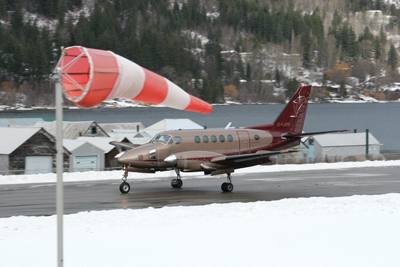
Features
Safety
Wings on safety: Northern Composure
For many pilots, waking up in the morning and heading off to work can very quickly become routine.
April 15, 2010 By David Burke
For many pilots, waking up in the morning and heading off to work can very quickly become routine. You arrive at the airport, pick up your itinerary or flight routing, fill in the blanks on a flight plan, get the ground crew to pull your plane out of the hanger, and fill up with the appropriate amount of fuel. Before you know it, your workday has begun and your coffee is firmly planted in hand. But while this may be the drill for some pilots, for the Northern Canadian bush pilot, it’s far from reality.
 |
| It’s up to the pilot to properly assess the runway situation, and make correct decisions to ensure a safe flight.
PHOTO: Douglas Noblet
|
For them, it’s standard procedure to get up at 5 a.m., brush the snow off their plane, take the wing covers off in a 20 knot wind, or fuel up in –40C degree temperatures. To a bush pilot, it’s just another day at the office. And whether you’re a new pilot or a veteran of the skies, flying in Canada’s north can be an awe-inspiring experience. But it’s also rife with a new set of dangers and considerations.
It is not unusual to fly 200 miles without talking to a single person, or to make your own approach into a 2,000-foot gravel strip. Although narrowly clearing a pack of wild dogs on rotation isn’t exactly a daily occurrence, stories like that are not hard to come by. Local Cessna 206 pilot of High Level, Alta, Carolyn Kristensen came into close contact with a pack of wild horses while landing on a 3,500-foot gravel runway in Fox Lake, Northern Alberta.
“While on final approach, I noticed four wild horses grazing on grass about three-quarters of the way down the runway, just a few feet off the gravel,” explains Kristensen. “I knew I could be down and stopped before I reached the horses in case they decided to stroll out in front of me,” she says. “Once I was down and clear, I had to walk out and herd them away from the runway so I could take off again.”
Unlike flying in larger centres in Canada, flying in the north offers few of the amenities that are “standard” to pilots in other parts of the country. There is often no radar coverage, weather advisories, or air traffic control, and these are now added responsibilities of the pilot-in-command. It’s also not unusual for a pilot to have to call ahead to the destination to get a rundown of the runway condition. Quite often, the only person on the other end of the line may be a local resident who lives close to the strip.
An eye to the sky
As is true with many aviation jobs, coping with changing weather conditions is vitally important – and it’s critical for northern pilots. For example, when flying into a short 2,000-ft. gravel (or dirt) strip, every change in weather affects runway conditions.
New seasons also bring more than just temperature changes in northern locations. In spring, your runway may be riddled with puddles or have a river-like run-off flowing down the centre line. During frigid winter months, some eight to 10 inches of snow could be on the touchdown zone, or perhaps there are snow banks on either side of the runway which are too close in proximity to the wings for a safe landing.
While there’s no way to control such conditions, it’s up to the pilot to properly assess the situation, and make correct decisions to ensure a safe flight for all on board.
The training advantage
Most companies operating in Northern Canada offer in-house training to new pilots. This training is often more than a typical line indoctrination. It usually covers local knowledge that is helpful, if not essential, in certain situations. Many companies will not only perform necessary air work with new pilots, but will take them into each strip several times until they become accustomed to that runway.
“The main difference I noticed between flying here and flying in the U.S. was how I was taken out to each strip multiple times until I became comfortable with the area,” says Marvin Geddam, a local Cessna Caravan pilot residing in High Level, Alta. Geddam has been flying in the North for a year now, with prior experience as a flight instructor in central Florida. “To come from an area with lots of air traffic, three parallel runways and full radar coverage to here took some getting used to. But the help from the local pilots and an extensive line indoctrination made the transition much easier.”
There are indeed countless challenges facing today’s northern pilots, but for those willing to adapt to this type of flying, the rewards are endless.
David Burke is a medevac pilot based in High Level, Alta. He has flown in Northern Canada for the past three years and has experience in bush flying as well as operations in larger centres. He currently flies Cessna 206s and PA-31 Navajos.
This information is intended to increase overall safety awareness and is not a substitute for compliance with regulatory guidelines.
We welcome your feedback at akwasnik@annexweb.com.